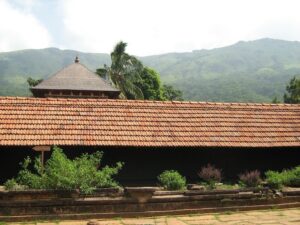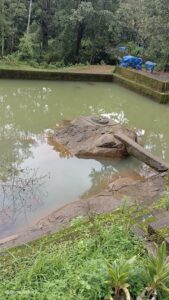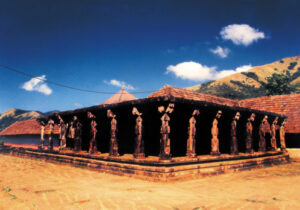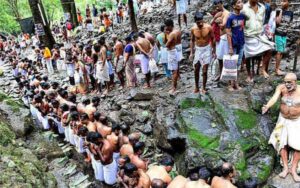Thirunelli Temple – Wayanand, Kerala:
In Kerala, India, close to the border with Karnataka state, there is an ancient temple called Thirunelli Temple (also spelt Tirunelli) that is dedicated to Lord Maha Vishnu. The temple sits in the northern Wayanad region at a height of roughly 900 metres, in a valley surrounded by majestic mountains. From Manathavady, it is 32 kilometres away.
Also Read:
Thirunelli Temple History:
The Chera king Kulasekharan is credited with founding this shrine.Between A.D. 767 and A.D. 834, he lived. He held the throne for a brief period before abdicating and beginning his missionary work to spread the Vaishnava order. He is credited with authoring the Sanskrit poem Mukundamaala, in which he sincerely begs Lord Vishnu to inspire devotion in him.
The word nelli, the Malayalam/Tamil term for the Indian gooseberry (Amla) tree, is where the name Thirunelli originates. When Lord Brahma was travelling the earth and came upon an idol of Lord Vishnu in the valley resting on an amla tree, he gave the place the name Thirunelli. There is mention of a stunning Vishnu temple in the Padma Purana, which was penned by Veda Vyasa, that is situated in the gorgeous Sahya valley, smack dab in the centre of the jungle. Amalaka and Sidha temples are other names for the Thirunelli temple.
The Tamil/Malayalam word nelli, which refers to the Indian gooseberry of the Amla tree, is where the name Thirunelli comes from. The 18 surviving Puranas were written by Veda Vyasa. Many Hindu texts, including the Matsya Purana, Skanda Purana, Narasimha Purana, Padma Purana, and others, refer to the stunning Vishnu temple as “Sahyamalaka Kshetra” and mention that Lord Brahma constructed it in the picturesque Sahya valley, smack dab in the middle of an unrivaled beautiful forest. According to legend, Lord Brahma was riding his hamsa around the universe when the beauty of the region that is now known as Brahmagiri Hill drew his attention.
Brahma descended there and saw an idol seated in an Amla tree. Brahma recognised the location as Vaikuntha (Vishnuloka) and the idol as the Lord Vishnu Himself. Brahma placed the idol there with the aid of the Devas, naming the place Sahyamalak Kshetra. Vishnu vowed that the area’s waters will wash away all sins in response to Brahma’s prayer. (Therefore, the nearby spring and river are known as Papanasini, which means “washes away all sins”).
Even today, the temple’s chief priest keeps some of the offerings outside because he believes that Lord Brahma would show up and conduct the pooja rituals during the early hours of the morning.
According to legend, Lord Vishnu Parasurama paid a visit to Thirunelli and attended the funeral rituals for the sage Jamadagni. In order to atone for his misdeeds related to the Kshatriya killings, he also underwent immersion in the Papanasini.
Importance of Thirunelli Temple:
Thirunelli is a special location where one can encounter the union of divine and natural energies. As a result, it becomes the perfect destination for a pilgrimage as well as a picturesque setting for taking use of nature’s gifts. An amazing sight is the sunrise over the Brahamagiri, which is the backdrop of the Thirunelli temple. For the pilgrims who arrive with ardour and devotion, Papanasini, Pinnappara, Panchatheertham, and Gunnika Temple are the other important locations.
Papanasini Stream:
Papanasini is a sacred mountain stream that may be reached about 1 km northwest of the temple grounds, emanating from the centre of the Brahmagiri forest and running through the roots, leaves, and blossoms of ancient trees and medicinal herbs. Because they believe that these waters have the potential to wash away sins, pilgrims take baths here. Additionally, the temple provides services for the burial of cremation ashes in the holy mountain stream, which will then be taken to the Kaveri River and ultimately the ocean. The final rites include this.
Panchatheertham:
The sacred temple pond is called Panchatheertham. The absence of a temple well is one remarkable aspect of the building. Thus, water is brought directly into the priests’ apartment by magnificent stone aqueducts from a perennial mountain stream that flows deep into the valley. The rock next to the Papa Nasini creek is where final rites are traditionally performed in Thirunelli.
Pinnappara:
According to legend, this rock contains the bone of Pazhana-bhedi, an asuran (demon) slain by Vishnu. At the time of his death, he prayed to Vishnu for the transformation of his body into a rock that would extend from Thirunelli to Gaya and be divided into three sections suitable for the performance of offerings for the dead, with Thirunelli standing in for his foot, Godavari for the middle section, and Gaya for the head. Offerings made at any one of these three locations are said to have specific advantages in bringing about happiness and in appeasing the spirits. At Pinnappara in Thirunelli, ritual offerings are presented to the spirits, especially on the days of the New Moon in the Malayalam months of Karkkidakom, Thulam, and Kumbham.
Gunnika Temple:
A modest bridge may be seen about halfway along the riverbed as you make your way from the Thirunelly temple to Papanasini. Pass over this to reach the Lord Siva-themed Gunnika cave temple. According to legend, a pilgrim’s fruit (another Nelli fruit) that he had just finished taking a bath in the Papanashini transformed into a Phallus (Shiva linga).
Thirunelli Temple Timings:
The timings of thirunelli Temple: Morning: 5:30 am to 12:00 pm, Evening: 5:30 pm to 8:00 pm
Visit:
Poojas and Rituals at Thirunelli Temple:
Pithrukarma: Worshippers can offer prayers to their ancestors at a sacred rock located within the temple complex.
The temple also follows a number of traditions that cover the whole cycle of life. There are also additional funeral rites performed here, such as Bali Tharpana and Oraalpindam.
At the Thirunelli Temple, Brahmanas also engage in musical performance while making food offerings to Lord Vishnu.
Ritual at the Papanasini River: To carry out the ancestral rites, pilgrims from all over the world assemble at the Thirunelli Temple. The river’s banks are where the rites take place. The holy waters, according to locals, are able to wash away all deadly sins.
Thirunelli Temple Accommodation:
Rooms are provided by thirunelli temple wayanand. They are:
Panchatheertham Vishrama Mandiram
Himagiri Homes
The details of rooms are check in official website – https://thirunellitemple.com/accomadation.php
Thirunelli Temple Official Website – https://thirunellitemple.com/
Thirunelli Temple Location – Thirunelly, Kerala 670646
Thirunelli temple contact number – 8547 336201, 8547 244055, 04935 210201.
Thirunelli temple Dress Code:
Most devotees dress traditionally when they arrive. Men are not allowed to wear shirts within the shrine. The temple compound prohibits the entry of leather items and clothing. The priest’s office sells dhotis, which are required for worship.
Festivals at Thirunelli Wayanand:
The main festivals celebrated at the temple are Puthari, Chuttuvilakku, Navarathri, Shivarathri, and Sreekrishnajayanthi.
Temples near to Thirunelli temple:
Trisillery temple
Kottiyur Temple
Kalpetta
How to reach Thirunelli temple Kerala:
By Air: The Thirunelli Temple is close to the Calicut International Airport. The airport is also known as Karipur Airport. The Thirunelli Temple is 161 km away from this airport.
By Train: Calicut is home to the closest rail station to the temple. Tourists must first travel to Mananthavady and then Thirunelli from the train station. Mysore railway station is the one that is next closest to the temple.
thirunelli temple to kuruva island distance – 55 min (22.0 km) via Kuruva Dweep Rd
Kalpetta to Pakshipathalam distance – 38.7 kms
Hotels at Thirunelli Temple:
Mayookham Resort
Dakshinakasi Guest House
Theertham Lodge
agraharam resort
KTDC Tamarind Thirunelly
Wayanad Nest Homestay
Thirunelli Temple Photos:





